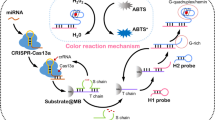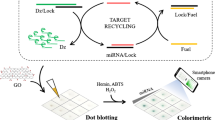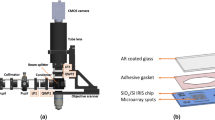Abstract
Enabled by the coffee-ring effect, a paper-based signal transduce method is employed for catalytic hairpin assembly (CHA) amplification and hybridization chain reaction (HCR) to achieve miRNA quantification. Once the target miRNAs appeared, it was circularly used by CHA to initiate HCR amplification to produce a large number of G-quadruplex, which is combined with hemin to form a hemin/G-quadruplex DNAzyme. The DNAzyme catalyzes a colorimetric reaction to produce colored nanoparticles, which were converted to the end edge of the paper by evaporation-driven flow, forming a visible colored band. Higher concentration of miRNA led to more colored nanoparticles and thus a longer colored band that can simply be measured by a ruler. The results of determination of miRNA in samples demonstrate that the relative standard deviation of the proposed approach is 5.2%, highly sensitive and repeatable, with a working range 1.0 to 1000 pM and a LOD of 0.2 pM. The paper-based analytical device as a novel platform offers a new signal transduce pathway toward the detection of low-abundance biomarkers for diagnosis.
Graphical abstract

Schematic representation of the principle for quantification of miRNA on paper based on the coffee-ring effect.





Similar content being viewed by others
References
Wu L, Qu X (2015) Cancer biomarker detection: recent achievements and challenges. Chem Soc Rev 44:2963–2997
Kanodra NM, Silvestri GA, Tanner NT (2015) Screening and early detection efforts in lung cancer. Cancer 121:1347–1356
Meng J, Zhang P, Zhang F, Liu H, Fan J, Liu X, Yang G, Jiang L, Wang S (2015) A self-cleaning TiO2 nanosisal-like coating toward disposing nanobiochips of cancer detection. ACS Nano 9:9284–9291
Liu X, Dai Q, Austin L, Coutts J, Knowles G, Zou J, Chen H, Huo Q (2008) A one-step homogeneous immunoassay for cancer biomarker detection using gold nanoparticle probes coupled with dynamic light scattering. J Am Chem Soc 130:2780–2782
Stern E, Vacic A, Rajan NK, Criscione JM, Park J, Ilic BR, Mooney DJ, Reed MA, Fahmy TM (2010) Label-free biomarker detection from whole blood. Nat Nanotechnol 5:138–142
Law W-C, Yong K-T, Baev A, Prasad PN (2011) Sensitivity improved surface plasmon resonance biosensor for cancer biomarker detection based on plasmonic enhancement. ACS Nano 5:4858–4864
Broza YY, Zhou X, Yuan M, Qu D, Zheng Y, Vishinkin R, Khatib M, Wu W, Haick H (2019) Disease detection with molecular biomarkers: from chemistry of body fluids to nature-inspired chemical sensors. Chem Rev 119:11761–11817
Song Y, Gyarmati P (2019) Visual detection of bacterial DNA using activated paper stripe. Mikrochim Acta 186:642
Chen A, Ma S, Zhuo Y, Chai Y, Yuan R (2016) In situ electrochemical generation of electrochemiluminescent silver naonoclusters on target-cycling synchronized rolling circle amplification platform for MicroRNA detection. Anal Chem 88:3203–3210
Zhang D, Gao B, Zhao C, Liu H (2019) Visualized quantitation of trace nucleic acids based on the coffee-ring effect on colloid-crystal substrates. Langmuir 35:248–253
Zhang D, Bian F, Cai L, Wang T, Kong T, Zhao Y (2019) Bioinspired photonic barcodes for multiplexed target cycling and hybridization chain reaction. Biosens Bioelectron 143:111629
Duan R, Zuo X, Wang S, Quan X, Chen D, Chen Z, Jiang L, Fan C, Xia F (2013) Lab in a tube: ultrasensitive detection of microRNAs at the single-cell level and in breast cancer patients using quadratic isothermal amplification. J Am Chem Soc 135:4604–4607
Ge L, Wang W, Hou T, Li F (2016) A versatile immobilization-free photoelectrochemical biosensor for ultrasensitive detection of cancer biomarker based on enzyme-free cascaded quadratic amplification strategy. Biosens Bioelectron 77:220–226
Chen Y, Guo X, Liu W, Zhang L (2019) Paper-based fluorometric immunodevice with quantum-dot labeled antibodies for simultaneous detection of carcinoembryonic antigen and prostate specific antigen. Mikrochim Acta 186:112
Choi JR, Yong KW, Tang R, Gong Y, Wen T, Yang H, Li A, Chia YC, Pingguan-Murphy B, Xu F (2017) Lateral flow assay based on paper-hydrogel hybrid material for sensitive point-of-care detection of dengue virus. Adv Healthc Mater 6:1600920–1600929
Ran B, Xianyu Y, Dong M, Chen Y, Qian Z, Jiang X (2017) Bioorthogonal reaction-mediated ELISA using peroxide test strip as signal readout for point-of-care testing. Anal Chem 89:6113–6119
Chen Y, Xianyu Y, Wu J, Dong M, Zheng W, Sun J, Jiang X (2017) Double-enzymes-mediated bioluminescent sensor for quantitative and ultrasensitive point-of-care testing. Anal Chem 89:5422–5427
Soda Y, Citterio D, Bakker E (2019) Equipment-free detection of K(+) on microfluidic paper-based analytical devices based on exhaustive replacement with ionic dye in ion-selective capillary sensors. ACS Sens 4:670–677
Zhu Z, Guan Z, Liu D, Jia S, Li J, Lei Z, Lin S, Ji T, Tian Z, Yang CJ (2015) Translating molecular recognition into a pressure signal to enable rapid, sensitive, and portable biomedical analysis. Angew Chem Int Ed 54:10448–10453
Wu T, Yang Y, Cao Y, Song Y, Xu LP, Zhang X, Wang S (2018) Bioinspired DNA-inorganic hybrid nanoflowers combined with a personal glucose meter for onsite detection of miRNA. ACS Appl Mater Interfaces 10:42050–42057
Ma X, Wang Z, He S, Chen C, Luo F, Guo L, Qiu B, Lin Z, Chen G, Hong G (2019) Development of an immunosensor based on the exothermic reaction between H2O and CaO using a common thermometer as readout. ACS Sens 4:2375–2380
Chen C, Song G, Ren J, Qu X (2008) A simple and sensitive colorimetric pH meter based on DNA conformational switch and gold nanoparticle aggregation. Chem Commun 46:6149–6151
Wang L, Chen C, Huang H, Huang D, Luo F, Qiu B, Guo L, Lin Z, Yang H (2018) Sensitive detection of telomerase activity in cancer cells using portable pH meter as readout. Biosens Bioelectron 121:153–158
Wang R, Du X, Zhai J, Xie X (2019) Distance and color change based hydrogel sensor for visual quantitative determination of buffer concentrations. ACS Sens 4:1017–1022
Shangguan JW, Liu Y, Wang S, Hou YX, Xu BY, Xu JJ, Chen HY (2018) Paper capillary enables effective sampling for microfluidic paper analytical devices. ACS Sens 3:1416–1423
Cate DM, Noblitt SD, Volckens J, Henry CS (2015) Multiplexed paper analytical device for quantification of metals using distance-based detection. Lab Chip 15:2808–2818
Song Y, Zhang Y, Bernard PE, Reuben JM, Ueno NT, Arlinghaus RB, Zu Y, Qin L (2012) Multiplexed volumetric bar-chart chip for point-of-care diagnostics. Nat Commun 3:1283
Tian T, Li J, Song Y, Zhou L, Zhu Z, Yang CJ (2016) Distance-based microfluidic quantitative detection methods for point-of-care testing. Lab Chip 16:1139–1151
Wei X, Tian T, Jia S, Zhu Z, Ma Y, Sun J, Lin Z, Yang CJ (2016) Microfluidic distance readout sweet hydrogel integrated paper-based analytical device (muDiSH-PAD) for visual quantitative point-of-care testing. Anal Chem 88:2345–2352
Gong L, Zhao Z, Lv Y-F, Huan S-Y, Fu T, Zhang X-B, Shen G-L, Yu R-Q (2015) DNAzyme-based biosensors and nanodevices. Chem Commun 51:979–995
Liu J, Lu Y (2003) A colorimetric lead biosensor using DNAzyme-directed assembly of gold nanoparticles. J Am Chem Soc 125:6642–6643
Shimron S, Wang F, Orbach R, Willner I (2011) Amplified detection of DNA through the enzyme-free autonomous assembly of hemin/G-quadruplex DNAzyme nanowires. Anal Chem 84:1042–1048
Guo Y, Chen J, Cheng M, Monchaud D, Zhou J, Ju H (2017) A thermophilic tetramolecular G-quadruplex/hemin DNAzyme. Angew Chem Int Ed 56:16636–16640
Deegan RD, Bakajin O, Dupont TF, Huber G, Nagel SR, Witten TA (1997) Capillary flow as the cause of ring stains from dried liquid drops. Nature 389:827–829
Huang C, Wang J, Lv X, Liu L, Liang L, Hu W, Luo C, Wang F, Yuan Q (2018) Redefining molecular amphipathicity in reversing the "coffee-ring effect": implications for single base mutation detection. Langmuir 34:6777–6783
Zhang D, Ma B, Tang L, Liu H (2018) Toward quantitative chemical analysis using a ruler on paper: an approach to transduce color to length based on coffee-ring effect. Anal Chem 90:1482–1486
Zhang D, Gao B, Chen Y, Liu H (2018) Converting color to length based on the coffee-ring effect for quantitative immunoassays using a ruler as readout. Lab Chip 18″:271–275
Soltman D, Subramanian V (2008) Inkjet-printed line morphologies and temperature control of the coffee ring effect. Langmuir 24:2224–2231
Wen JT, Ho CM, Lillehoj PB (2013) Coffee ring aptasensor for rapid protein detection. Langmuir 29:8440–8446
Zhang Z, Zhang X, Xin Z, Deng M, Wen Y, Song Y (2013) Controlled inkjetting of a conductive pattern of silver nanoparticles based on the coffee-ring effect. Adv Mater 25:6714–6718
Marsico AL, Duncan B, Landis RF, Tonga GY, Rotello VM, Vachet RW (2017) Enhanced laser desorption/ionization mass spectrometric detection of biomolecules using gold nanoparticles, matrix, and the coffee ring effect. Anal Chem 89:3009–3014
Funding
We gratefully acknowledge the Fundamental Research Funds for the Central Universities (2242018 K41023). This work was supported by the Key Project and Open Research Fund of State Key Laboratory of Bioelectronics, Southeast University. This work was supported by the Postdoctoral Science Foundation of China (2019 M012945; 2019 M653061), the General Project of Basic Research in Shenzhen, the Suzhou Engineering and Technological Research Center of Natural Medicine and Functional Food (grant no. SZ2017ZX06), and the Anhui Natural Science Foundation of China (grant no. 2008085QH365).
Author information
Authors and Affiliations
Corresponding authors
Ethics declarations
Conflict of interest
The authors declare that they have no conflict of interest.
Additional information
Publisher’s note
Springer Nature remains neutral with regard to jurisdictional claims in published maps and institutional affiliations.
Electronic supplementary material
ESM 1
(DOCX 2781 kb)
Rights and permissions
About this article
Cite this article
Zhang, D., Wu, C., Luan, C. et al. Distance-based quantification of miRNA-21 by the coffee-ring effect using paper devices. Microchim Acta 187, 513 (2020). https://doi.org/10.1007/s00604-020-04500-7
Received:
Accepted:
Published:
DOI: https://doi.org/10.1007/s00604-020-04500-7




